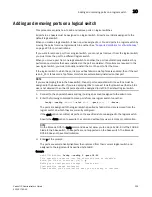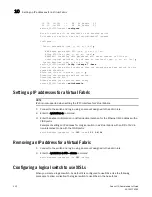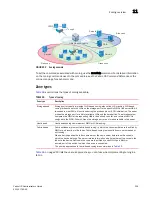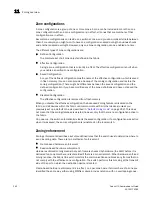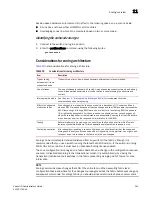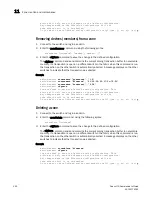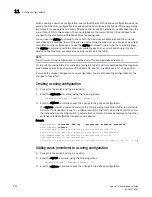
242
Fabric OS Administrator’s Guide
53-1001763-02
Zoning overview
11
Zone configurations
A
zone configuration
is a group of one or more zones. A zone can be included in more than one
zone configuration. When a zone configuration is in effect, all zones that are members of that
configuration are in effect.
Several zone configurations can reside on a switch at once, and you can quickly alternate between
them. For example, you might want to have one configuration enabled during the business hours
and another enabled overnight. However, only one zone configuration can be enabled at a time.
The different types of zone configurations are:
•
Defined Configuration
The complete set of all zone objects defined in the fabric.
•
Effective Configuration
A single zone configuration that is currently in effect. The effective configuration is built when
you enable a specified zone configuration.
•
Saved Configuration
A copy of the defined configuration plus the name of the effective configuration, which is saved
in flash memory. (You can also provide a backup of the zoning configuration and restore the
zoning configuration.) There might be differences between the saved configuration and the
defined configuration if you have modified any of the zone definitions and have not saved the
configuration.
•
Disabled Configuration
The effective configuration is removed from flash memory.
When you disable the effective configuration, the Advanced Zoning feature is disabled on the
fabric, and all devices within the fabric can communicate with all other devices (unless you
previously set up a default zone, as described in
“Default zoning mode”
on page 252). This does
not mean that the zoning database is deleted, however, only that there is no configuration active in
the fabric.
On power-up, the switch automatically reloads the saved configuration. If a configuration was active
when it was saved, the same configuration is reinstated on the local switch.
Zoning enforcement
Zoning enforcement describes a set of predefined rules that the switch uses to determine where to
send incoming data. There are two methods of enforcement:
•
Frame-based hardware enforcement
•
Session-based hardware enforcement
Hardware-enforced zoning means that each frame is checked by hardware (the ASIC) before it is
delivered to a zone member and is discarded if there is a zone mismatch. When hardware-enforced
zoning is active, the Fabric OS switch monitors the communications and blocks any frames that do
not comply with the effective zone configuration. The switch performs this blocking at the transmit
side of the port on which the destination device is located.
Frame-based hardware enforcement is in effect, on a per-zone basis, if all members of a zone are
identified the same way, either using WWNs or
domain,index
notation, with no overlapping zones.
Содержание 53-1001763-02
Страница 1: ...53 1001763 02 13 September 2010 Fabric OS Administrator s Guide Supporting Fabric OS v6 4 0 ...
Страница 4: ...iv Fabric OS Administrator s Guide 53 1001763 02 ...
Страница 24: ...xxiv Fabric OS Administrator s Guide 53 1001763 02 ...
Страница 28: ...xxviii Fabric OS Administrator s Guide 53 1001763 02 ...
Страница 32: ...xxxii Fabric OS Administrator s Guide 53 1001763 02 ...
Страница 40: ...xl Fabric OS Administrator s Guide 53 1001763 02 ...
Страница 42: ...2 Fabric OS Administrator s Guide 53 1001763 02 ...
Страница 54: ...14 Fabric OS Administrator s Guide 53 1001763 02 High availability of daemon processes 1 ...
Страница 74: ...34 Fabric OS Administrator s Guide 53 1001763 02 Basic connections 2 ...
Страница 102: ...62 Fabric OS Administrator s Guide 53 1001763 02 Audit log configuration 3 ...
Страница 156: ...116 Fabric OS Administrator s Guide 53 1001763 02 The authentication model using RADIUS and LDAP 5 ...
Страница 214: ...174 Fabric OS Administrator s Guide 53 1001763 02 Management interface security 7 ...
Страница 228: ...188 Fabric OS Administrator s Guide 53 1001763 02 Brocade configuration form 8 ...
Страница 276: ...236 Fabric OS Administrator s Guide 53 1001763 02 Creating a logical fabric using XISLs 10 ...
Страница 404: ...364 Fabric OS Administrator s Guide 53 1001763 02 ...
Страница 440: ...400 Fabric OS Administrator s Guide 53 1001763 02 Performance data collection 17 ...
Страница 464: ...424 Fabric OS Administrator s Guide 53 1001763 02 Disabling bottleneck detection on a switch 18 ...
Страница 480: ...440 Fabric OS Administrator s Guide 53 1001763 02 F_Port masterless trunking 19 ...
Страница 494: ...454 Fabric OS Administrator s Guide 53 1001763 02 Buffer credit recovery 20 ...
Страница 560: ...520 Fabric OS Administrator s Guide 53 1001763 02 Port indexing on the Brocade DCX 4S backbone C ...
Страница 574: ...534 Fabric OS Administrator s Guide 53 1001763 02 Hexadecimal overview E ...


